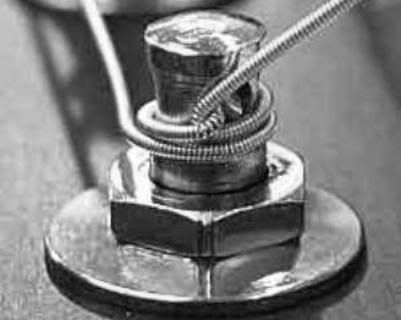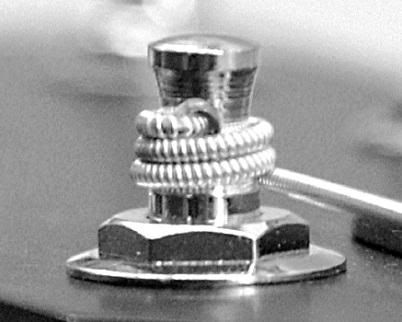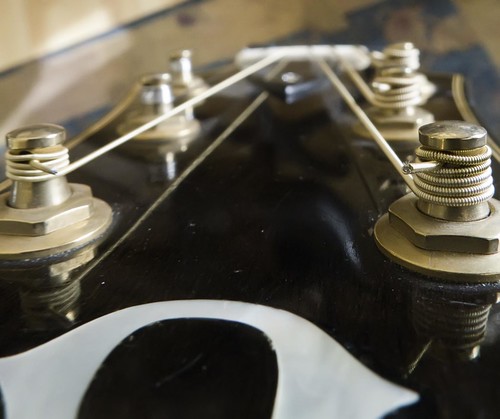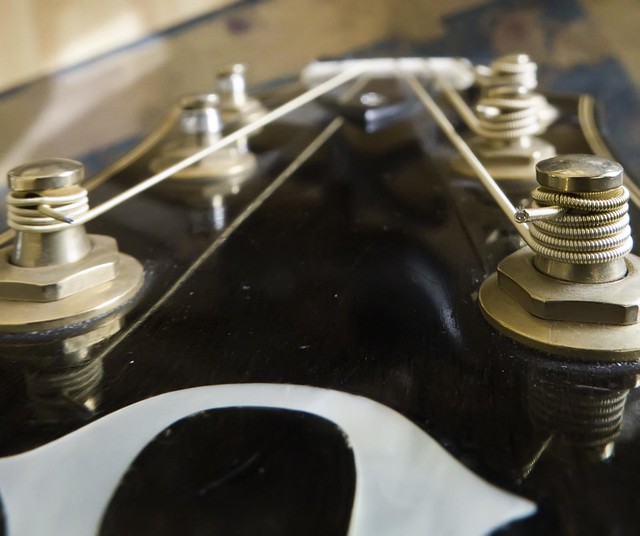
 |
|
#1
|
|||
|
|||
|
Seems whenever the topic of "How do I restring" comes up there are a quite a few popular methods that suggested. My question would be does it really matter which one you use?
I switched to the Taylor method that does not involve a lock wrap and was dubious at first. Having used it, I have never had any slippage or tuning issues. Other methods abound but do any really have an advantage over others if the string is secure to the post and you don't experience slippage or tuning problems. Is there any popular method that does cause problems? |
|
#2
|
|||
|
|||
|
Quote:
I used to use the ""one over/rest under" string-locking method,  but have been using the "cut to fit then all under wrap" (so called Taylor) method for sometime.  Either one holds the strings just as securely, and the all-under way is a bit faster. |
|
#3
|
||||
|
||||
|
Quote:
Sometimes it matters which one you use…on slot heads for instance, some guitars are designed so the outside strings duck under the others at the nut. And with round core strings you should not pre-cut them or you will unravel them. If you don't have a work bench handy, or a long stretch of counter that's high and comfortable then learning to string them in your lap may be more important. And if you are used to stringing them on the bench and then shell one out at a gig, what will one do? And if you are one who sits it in your lap, attaches strings at the bridge and then throws a loop at the tuning peg, & tightens: if you needed/wnated to increase the number of winds at the peg, you'd have to modify your style. I've messed around with lots of methods and settled on one that's good for me. I'm not sure one method is better than another from a technical standpoint, but being able to change strings quickly and efficiently is important to me. And I use ''one wrap above and several below'' method...   |
|
#4
|
|||
|
|||
|
My experience is the same as HHP's and Misty's; I no longer bother with the locking wrap.
I do, however try to get enough wraps so that the string is forced down to the bottom of the peg. This is to get the largest possible break angle on the nut. One can see in ljguitar's photo that the G-string has hardly an break angle on the nut. The D-string is a little better, but still could use another wrap or two. One could claim that the nut break angle makes no difference; I would not dispute it since I haven't ever tested it. |
|
#5
|
|||
|
|||
|
Quote:
There is a variation of the Taylor method that eliminates the extensive number of turns needed on the tuning knob. Stick the end in the hole before pegging the ball end at the bridge. Next wrap downward the number of coils desired leaving enough slack to still get the ball end into the bridge hole. It then takes fewer turns to tension to pitch. I haven't tried it but feel my clumsy fingers would struggle way to much. I don't mind winding. I find that with a little practice I can spin that string winder really fast. it's all in the wrist. Kinda like strumming. Taylor method has never slipped for me and I have yet to break a string at the tuner. Mine go at the saddle from beating on it too hard. |
|
#6
|
|||
|
|||
|
Quote:
one of my questions for slot head guitars is if it makes sense to try and get a straighter string through with the windings, to avoid binding at the nut, or if they should be angled to be more prone to press against each other. |
|
#7
|
|||
|
|||
|
I've been using what's now called "The Taylor Method" since about 1976, when it was shown to me by the guy who built my dulcimer. He'd just been to a bluegrass festival where he'd witnessed some of the guitarists there using what they called "the fishhook method" to restring. They also stretched in the strings at the same time, which allowed them to change strings between sets yet have their new strings remain stable enough to use onstage immediately afterwards.
Been doing it that way ever since. The only stringed instruments that I've found that really need to have the strings locked onto the tuner post are the high fifth string of a banjo, the A and E courses of a mandolin, and the high octave D and G strings on a 12 string guitar. So I loop around and tie those strings to themselves, but on all the rest of the strings on those instruments I use the fishhook method. Wade Hampton Miller |
|
#8
|
||||
|
||||
|
I'm with Larry J, except less wraps. One over, 2 under and I've never had any issues. I measure one post extra plus a smidge and that usually works out to 3 wraps or so. (I put a 120 degree bend on the A string just past the D post). I do the exact same thing on the slot-heads with the exception of changing the "over/under" to inside/outside. On the E strings its one in/2 out. and the other 4 are one out/2 in. That helps the strings come over the nut straighter. Just what I do - tried most of the other ways - this is just the fastest and least chance of scratching anything for me.
|
|
#9
|
|||
|
|||
|
I use Wade's "fishhook" method that I figured out for myself many years ago before the Internet, and I use a fair number of wraps as is shown in Larry's photos of his Olson.
When I used to play a lot on stage, if I broke a string it always seemed to be the G string. And it typically broke at the saddle. I kept a piece of sandpaper in my case to lightly file away any stress concentrations at the saddle and then would sometimes reattach the string ball to the broken G string, unwind a couple of wraps on the post and then could repair the broken string in a few minutes even if I didn't have another G string in my case. I don't play out anymore, but I still have that habit of more wraps on the post from those days. I have tried the other methods, the Taylor method and locking wrap, but I like the fishhook method better, probably because I'm used to it. - Glenn |
|
#10
|
|||
|
|||
|
I'd swear that when I abandoned "one over several under" and did "Taylor" method, I had more tuning issues. So I'm back to one over several under.
Also, at a member's suggestion I've tried stretching strings with tuning machines. Just pulling on them seemed imprecise and needlessly painful. I put the Snark on and tune each string briefly 1/2 step above the desired pitch until it's reasonably stable (a few seconds) before backing down to final pitch. So far it's working; my strings never sounded better or lasted longer.
__________________
2010 Taylor GA3 |
|
#11
|
|||
|
|||
|
+1 on the "Taylor" method ... precise, consistent, easy, fast, dependable ... what else do we need?
__________________
"Alas for those that never sing, But die with all their music in them!" --- Oliver Wendell Holmes Hear my original music at: https://www.reverbnation.com/judsonhair |
|
#12
|
|||
|
|||
|
I also switched to the Taylor method after using a locking method for 15 years. There is a nice video on the Taylor website. I like the Taylor method the best....seems to be the most consistent and fastest way to restring my guitar.....and also looks great. Any re-tuning I do after the strings have settled in is very minor and is typically due to weather/room humidity. At least for my Taylor this seems to be the best method....I am sure other guitars and the way they are set-up and their head stock designs may benefit from alternative stringing methods.
__________________
2010 Taylor 914ce 1979 Ovation Custom Legend |
|
#13
|
|||
|
|||
|
"Taylor method" fan here. I used to do the over/under since 1985ish...but switch to the taylor method. I have no tuning issues, and for me the end result looks much neater.
If I break a string at a gig, I do the over/under method because I don't necessarily have wire cutters to clip the string (which is kind of required to do the taylor method).
__________________
'17 Waterloo Scissortail '17 David Newton 00 Rosewood '11 Homemade Strat Ibanez AS73 w/ Lollar P90s |
|
#14
|
||||
|
||||
|
Hi folks...
I just have to state for the record that Taylor has had 2 methods over the decades, and both were referred to as the Taylor-method. Both were on the website and in brochures (not at the same time), and both are in use today by many folks who swear by them. The first was to insert the string fully, then back it up one peg's worth and wind so there was one wrap above the hole, and the rest below allowing the 'pinch' to hold the string in place on the shaft. Cutting/trimming came after. The second was to pre-cut the string, pull it back and wind every wrap below the hole. This works except for round-core strings which will unravel if you pre-cut them before wrapping them around the shaft. Both were in deference to the Martin wrap which involved ''running over'' the string end to lock it in place (and resulted in many punctured fingertips later when it was being untangled and removed). I fell in with a variation of the one-over-rest-under method about 1999, and still use it today. It's the one I'm good at, and since I do a lot of alternate and open tunings, I put at least 2-4 wraps under on the wound strings, and even more on strings 1-2. Keeps strings from breaking while frequently retuning. More wraps also assures that the break angle and string trailing out of the nut is applying proper pressure in the nut slot. Many claim they love the "Taylor Method" which may not be the same thing for all of us!  |
|
#15
|
|||
|
|||
|
I love that photo of your wraps LJ . You can see the value of having several neat clean wraps with no lumps or pinches in the last few turns. I think I read somewhere that guitars strings flex or stretch slightly all the way past (and through) the nut and into the tuner was we play them. Having no lumps or sharp changes, and those nice smooth curves around the post should help keep them happy.
|